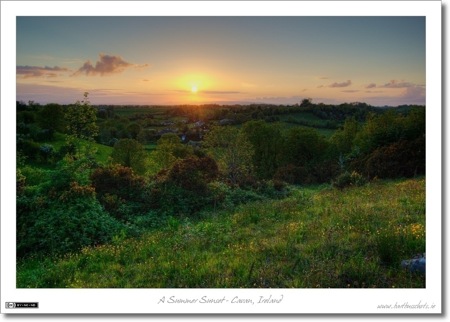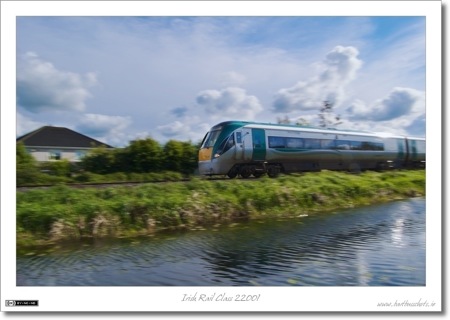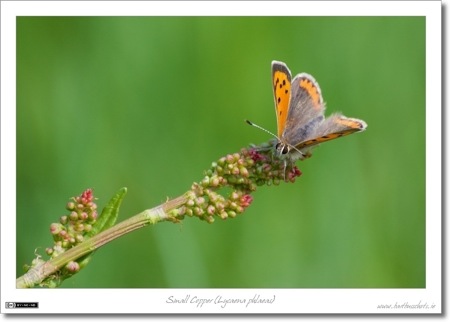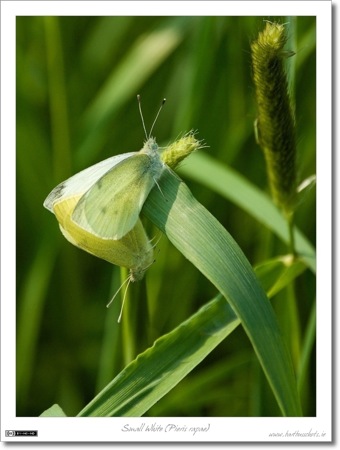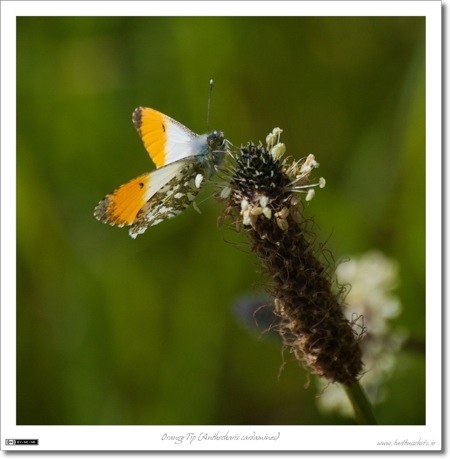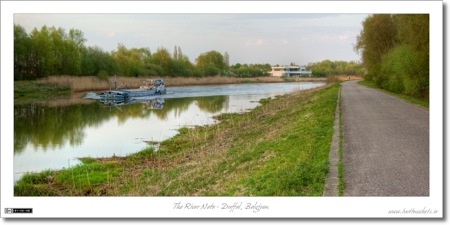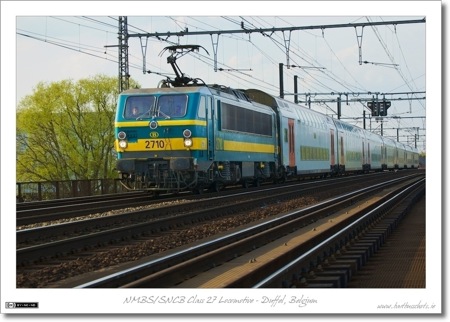Jul
4
Photo of the Week 71 & 72 – A Cavan Sunset
Filed Under Photography | 4 Comments
I’ve found myself one week behind yet again, so, for what seems like the millionth time, I’m doing a double-post this weekend. As always with these multiple posts, I’m choosing two related photos, in this case, VERY related photos, they were both taken within a few minutes of each other of the very same subject! The reason I’ve chosen to do these together is because they show two approaches to the same situation.
When you shoot a sunset the dynamic range is exceptionally high. You are shooting into the sun, and at the same time, the ground is getting dark, so, you have a very bright subject, with very dark surroundings. The range between the brightest and darkest range of the scene is just too big for a camera to take in. This leaves you with a choice between two approaches, both of which can make for fantastic photos.
As a complete geek, my first reaction is to throw technology at the problem. Although the technology I threw at the problem is quite modern (HDR photography), the idea is not new. In the past people would use graduated filters to solve the same problem. With a graduated filter the top of the filter blocks quite a lot of light, the bottom, none. You can get filters that have very abrupt graduations where half the filter is dark, the other half completely transparent with a very short transition between the two regions, or you can have filters that go smoothly from dark to light over the entire length of the filter. Different situations will call for different filters, but the aim is the same, get both the bright bits and the dark bits properly exposed despite the large difference in brightness between them (i.e. the large dynamic range). I don’t own any filters, so that’s not what I did. Instead, I used a technique called Tonemapping on a RAW file. The result is that you can see detail in both the bright sky and the dark landscape in this shot, which is the first of my two photos for this week:
- Camera: Nikon D40
- Lens: Nikon DX AFS 18-55mm (D40 kit lens)
- Exposure: 1/320 sec
- Focal Length: 18mm
- Focal Ratio: f/8
- ISO: 200
- Camera Mode: Aperture Priority
- Exposure Bias: -1.0EV
- Processing: Generated by tonemapping a single RAW file in Photomatix Pro.
So that’s an example of taking the first option for dealing with a high dynamic range, use technology to get around it. So what’s the second option? Don’t fight it, accept it, and use it! If you can’t get everything exposed properly, don’t even try, instead, intentionally only expose for one element. With a sunset that one element is the sky, and then you intentionally throw the rest into silhouette. You intentionally take away all exposure in your foreground! This can result in a lot of black space in your image, so you often have to crop pretty hard to make this work well. An example of this is the second image I’ve chosen for this week:
- Camera: Nikon D40
- Lens: Nikon DX AFS 18-55mm (D40 kit lens)
- Exposure: 1/640 sec
- Focal Length: 55mm
- Focal Ratio: f/8
- ISO: 200
- Camera Mode: Aperture Priority
- Exposure Bias: -2.0EV
Jul
4
A Quick Review of Syrinx – A Native OS X Twitter Client
Filed Under Computers & Tech | Leave a Comment
I recently moved to a new machine (a hand-me-down G5 20″ iMac), and when it came to installing my new apps I decided I’d had enough of Adobe AIR and the whole idea of web apps pretending (poorly) to be native apps. I like OS X, and I want the full power of OS X in my apps. I also like how OS X apps all look and work similarly to each other. You just don’t get that with AIR apps like Twhirl (which had been my Twitter client up to that point). Not long before I got my new Mac listener Scott had contributed a short review of Syrinx to the NosillaCast, so I decided to give it a go.
I took and instant liking to the app because it’s a proper OS X app, because it uses the OS X keychain to securely save my password, and because it has Growl support. The fact that it’s free also helps of course! I’ve been using it for a month or so at this stage, and I’m still happy enough with it to keep it as my current client on all three of my Macs. It’s also under very active development at the moment with updates coming out regularly, so I have high hopes for this app’s future.
Jun
25
Photo of the Week 70 – Speeding to Dublin
Filed Under Photography | 1 Comment
It seems like just far too long ago that I did a single Photo of the week post. sure, it’s late, but not so late as to need combining with next week’s post!
This is a fairly recent shot, and one that demonstrates the results of some recent experiments to spice up my train photos by creating motion blur in-camera. The idea is quite simple, set your camera to exposure priority mode, dial in the lowest exposure you can hand-hold and keep sharp, then shoot a moving object while panning with it. To give you a better chance of success, I also set the camera to burst mode and pan with the train while constantly shooting. Not every shot will be sharp, but by shooting a burst of 10 or so you have way more chance of getting a good shot!
- Camera: Nikon D40
- Lens: Nikon DX AFS 18-55mm (D40 kit lens)
- Exposure: 1/60 sec
- Focal Length: 18mm
- Focal Ratio: f/22
- ISO: 200
- Camera Mode: Aperture Priority
- Exposure Bias: -0.3EV
- Processing: Used Aperture’s Dodge & Burn plugin to darken the sky a little, lighten the foreground a little, and lighten the train a little more.
Jun
15
There can be no doubt that Twitter has taken off. It has become completely main-stream, and is rapidly rising in popularity and usage, last weekend’s twitpocalypse is proof of that! It would be nice to think that Twitter can remain the peaceful and relatively spam-free haven it is now, but I can see the start of the downward spiral already. Spam. Sure, you choose who you follow, and if you choose badly you can un-follow people, but does that prevent spam? Unfortunately it doesn’t. Anyone can message you using the @ sign, even if you don’t follow them. In many ways this is a great thing, for me, it lets listeners to my podcasts contact me without my having to give out my email address. However, this provides spammers with a mechanism to target people with their infuriating crap.
Jun
14
Photo of the Week 67, 68 & 69 – Butterflies
Filed Under Photography | 3 Comments
Between one thing and another I’ve missed the last two weekends so for the first time ever I’m doing a triple post for Photo of the week. Butterflies are an on-going photographic project of mine, so I thought I’d share three of my recent favourites with you all.
My first choice is a shot of a rather small butterfly, the Small Copper (Lycaena phlaeas). I much prefer the Flemish name for this little guy which translates as a Fire Butterfly, much more dramatic, and IMO, more appropriate! We have this species in Ireland too, but this shot was taken in Belgium when I spent a week there over Easter. This guy was surprisingly co-opperative, hanging around for a long time and letting me get close and get shots from lots of different angles. I got three really nice shots of this guy, but I’ve chosen this as my favourite because of the diagonal composition.
- Camera: Nikon D40
- Lens: Nikon DX AFS 55-200mm
- Exposure: 1/400 sec
- Focal Length: 200mm
- Focal Ratio: f/8
- ISO: 400
- Camera Mode: Aperture Priority
The second shot I’ve chosen is of a pair of Small Whites (Pieris rapae) mating on a grass stalk. Again, this is a species we have in Ireland, but the shot was again taken in Belgium. I like a lot of things about this shot, the grass bokeh, the grass seed stalk poking into focus at the right edge, and the overall composition, but what really makes it for me is how it illustrates the different colours these butterflies can be. They’re always white on top, but underneath they range from green to yellow, sometimes much deeper greens that in this shot.
- Camera: Nikon D40
- Lens: Nikon DX AFS 55-200mm
- Exposure: 1/800 sec
- Focal Length: 200mm
- Focal Ratio: f/8
- ISO: 400
- Camera Mode: Aperture Priority
- Exposure Bias: -1.0EV
Finally, my last choice is a recent shot I took here in Ireland on the section of towpath along the Royal Canal between Pike’s Bridge and Deey bridge between Maynooth & Leixlip. Much of the towpath has a gravel pathway along it, but this bit doesn’t, it’s pure nature for about a mile, almost constantly surrounded by trees, and passing through a cutting. You really feel like you’re out in the middle of nowhere, even though you’re no more than 10 minutes cycle from Maynooth or Leixlip. There are also much fewer people walking and cycling along the stretch, so you get to see much more wildlife. Like the Small Copper earlier, this guy also sat still for ages and let me get close and get lots of different angles. I picked this one as my favourite because I find the composition pleasing, and like how you can see both the top and underside of his wings, showing the cool patterns underneath, and the vibrant orange tip that gives this species it’s name, Orange Tip (Anthocharis cardamines). I also like the strange grassy flower he’s feeding on, Ribwort Plantain (Plantago lanceolata).
- Camera: Nikon D40
- Lens: Nikon DX AFS 55-200mm
- Exposure: 1/1000 sec
- Focal Length: 200mm
- Focal Ratio: f/8
- ISO: 400
- Camera Mode: Aperture Priority
- Exposure Bias: -1.0EV
Jun
11
Reflections on the WWDC 2009 Keynote
Filed Under Computers & Tech | 2 Comments
This is not going to be a full rundown of everything that was announced at Apple’s 2009 World Wide Developers Conference, not even nearly. It’s just my opinions on the things that caught my attention. If you don’t know what Apple announced you can watch the Keynote on Apple’s site.
Lets start by having a look at how I did on my predictions. I did pretty well over-all, as is to be expected when you don’t predict anything too exciting or special, but I did get one very major prediction wrong. I was adamant that there would be no new hardware at this evening, and what did Phil kick off with? New MacBook Pros! That was a total surprise, and not just to me.
Jun
8
I’m cutting it mighty fine this year, Phil Schiller gets up on stage in a matter of a few hours to deliver the WWDC 2009 keynote, but I still want to get a few predictions in beforehand. First and foremost, I expect this to be a very two-sided affair, iPhone, and OS X 10.6 SnowLeopard. I don’t expect we’ll see anything else, except maybe, just maybe, a pre-announcement about some sort of tablet device.
May
20
Photo of the Week 65 & 66 – Transportation in Duffel, Belgium
Filed Under Photography | Leave a Comment
Since I’m going to be away next weekend I’m combining this week’s photo of the week with next week’s to give yet another double-installment. As always when I combine two weeks into one, I’ve chosen a theme to unite both shots, in this case, transportation in the Belgian village of Duffel (my birthplace). In some ways these images span centuries. The first is of a heavily laden barge powering down the navigable river that passes through the village, the Nete. The Nete was the best transport link to the village for centuries, if not millennia! The second shows a train on the main line between Brussels and Antwerp which passes through Duffel. This is not the very oldest railway line in continental Europe, but it’s very close, being an extension of the very first one which ran from Brussels to Mechelen. That historic first section of what is now the line form Brussels to Antwerp opened on the 5th of May in 1835, while the remainder of the line, including this section in Duffel, opened a little less than a year later, on the 3rd of May in 1836.
Although Duffel is about 100km from the sea, Belgium is so flat that the Nete is still a tidal river as it passes through Duffel. In fact, at high tide many parts of the village are below the level of the river! For this reason the river is bordered by large dikes on both sides. These dikes are now paved, and serve the local communities as cycle and walking routes. It’s just north of Duffel that the river Nete now connects to the Nete Canal which brings shipping traffic up to the Albert Canal. Because of low bridges and the tidal nature of the river in Duffel, larger boats can only navigate the river at some times of the day, the water being too shallow at low tide, and the bridges too low at high tide. Smaller barges can navigate the river at any time without fear of running aground or crashing into bridges. In this shot we see a barge called Despatch making its way down-stream towards the village of Duffel at the very peak of high tide. As you can see by how low the barge is in the water, she’s clearly fully loaded, probably with coal, sand, or gravel. This kind of barge is low enough to pass under the bridges even at high tide.
- Camera: Nikon D40
- Lens: Nikon DX AFS 18-55mm (D40 kit lens)
- Exposure: 1/320 sec
- Focal Length: 40mm
- Focal Ratio: f/5
- ISO: 400
- Camera Mode: Aperture Priority
- Processing: lightly tonemapped in Photomatic Pro, then the barge was lightened slightly using Aperture’s Dodge & Burn plugin
My second chosen shot is of an evening express service from Antwerp to Brussels crossing the rail bridge over the Nete a little down-stream of Duffel village. This train is making its way along the same track bed that the first train between these two cities ran on way back in 1836. To put that into context, trains have been running here since 60 years after the (US) declaration of Independence. This train is made up of the best coaching stock the NMBS (Belgium’s national railway company, also know as the SNCB) has to offer. These M6 carriages give travellers two decks full of creature comforts on their short and speedy journey between Belgium’s two largest cities. The locomotive pulling the train is an NMBS Class 27 electric locomotive. Although these locomotives are approaching 30 years of age, they are still in fine condition and more than up to the task of whisking passengers between Belgian cities at speeds of up to 160km/h.
- Camera: Nikon D40
- Lens: Nikon DX AFS 18-55mm (D40 kit lens)
- Exposure: 1/500 sec
- Focal Length: 55mm
- Focal Ratio: f/5.6
- ISO: 400
- Camera Mode: Aperture Priority
- Processing: lightened the train a little using Aperture’s Dodge & Burn plugin
May
12
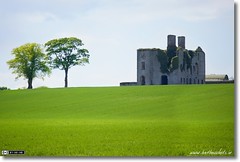 Being a week behind again this will be a double-edition of Photo of the Week. This time the ‘theme’ is that both chosen photos were taken on the same day, the 3rd of May 2009. They were taken on the first ever Typical Shutter Bug photo-walk in Ireland. Rather than just post the two chosen photos and a little description of each, I’m going to post a report on the photo-walk first. Then, at the end, I’ll post my two chosen photos with short descriptions. Before I start, I just want to give you all the link to my full photo gallery from the photo-walk on Flickr. It might be fun to follow along there since I’ve geo-tagged all my shots.
Being a week behind again this will be a double-edition of Photo of the Week. This time the ‘theme’ is that both chosen photos were taken on the same day, the 3rd of May 2009. They were taken on the first ever Typical Shutter Bug photo-walk in Ireland. Rather than just post the two chosen photos and a little description of each, I’m going to post a report on the photo-walk first. Then, at the end, I’ll post my two chosen photos with short descriptions. Before I start, I just want to give you all the link to my full photo gallery from the photo-walk on Flickr. It might be fun to follow along there since I’ve geo-tagged all my shots.
May
9
This is just a quick test post from a friend’s EeePC to see what they’re really like to type on and browse with. My very first impression, I think I have found something worse to type on than a virtual keyboard – a shrunken one! Since it has no smart helper-features like the iPhone, it is actually more tedious than the iPhone. You spend more time correcting mistakes because none of them are auto-corrected. Although you do get better at it as you keep typing, the location of the shift keys in particular really strain your hands. I’ve just typed this much and I can feel the strain already, this is very very far from ergonomic! I’m starting to see Tim Cook’s point, this is not a good experience, and I wouldn’t want Apple to clone this experience. I do want Apple to do something in this space, but it has to be something more human-friendly than this! This feels like miniaturisation for the sake of miniaturisation. I’m not sure what creatures the EeePC was designed for ergonomically, but it was most certainly not adult Homo sapiens! The one good thing I’ll say is that the screen is better than I was expecting, sure the resolution is small by real laptop or desktop standards, it’s positively roomy by iPhone standards. I think this would make it a usable web browser, but the keyboard is a waste of space, you can’t useit for serious typing. Take the screen from an EeePC, rotate it to portrail, make it multi-touch, add OS X iPhone, and make thinner, then you’d be on to a winner IMO! For ultimate p0wnage, add support for a bluetooth keyboad … oh … and sell it for the price of an EeePC 🙂







